K12 Math Lesson Plans: Shapes, Counting, and Comparisons
VerifiedAdded on 2023/06/05
|11
|2558
|260
Homework Assignment
AI Summary
This document presents three detailed lesson plans designed for K12 mathematics education, focusing on shapes, counting, and the concept of 'greater or less.' The first lesson plan introduces shapes to preschool children, incorporating activities to recognize and match shapes in the classroom. The second lesson plan focuses on counting from 1 to 10, suitable for preschool and kindergarten, and includes both indoor and outdoor activities. The third lesson plan targets first-grade students, introducing the concepts of 'greater or less' through sums, graphics, and comparisons. Each lesson plan includes learning objectives, EYLF outcomes, rationale, learning environment, risk management, a step-by-step plan, differentiation strategies, and assessment methods. Critical reflections on the effectiveness of each lesson plan are also provided, along with suggestions for future learning and expansion of the concepts.
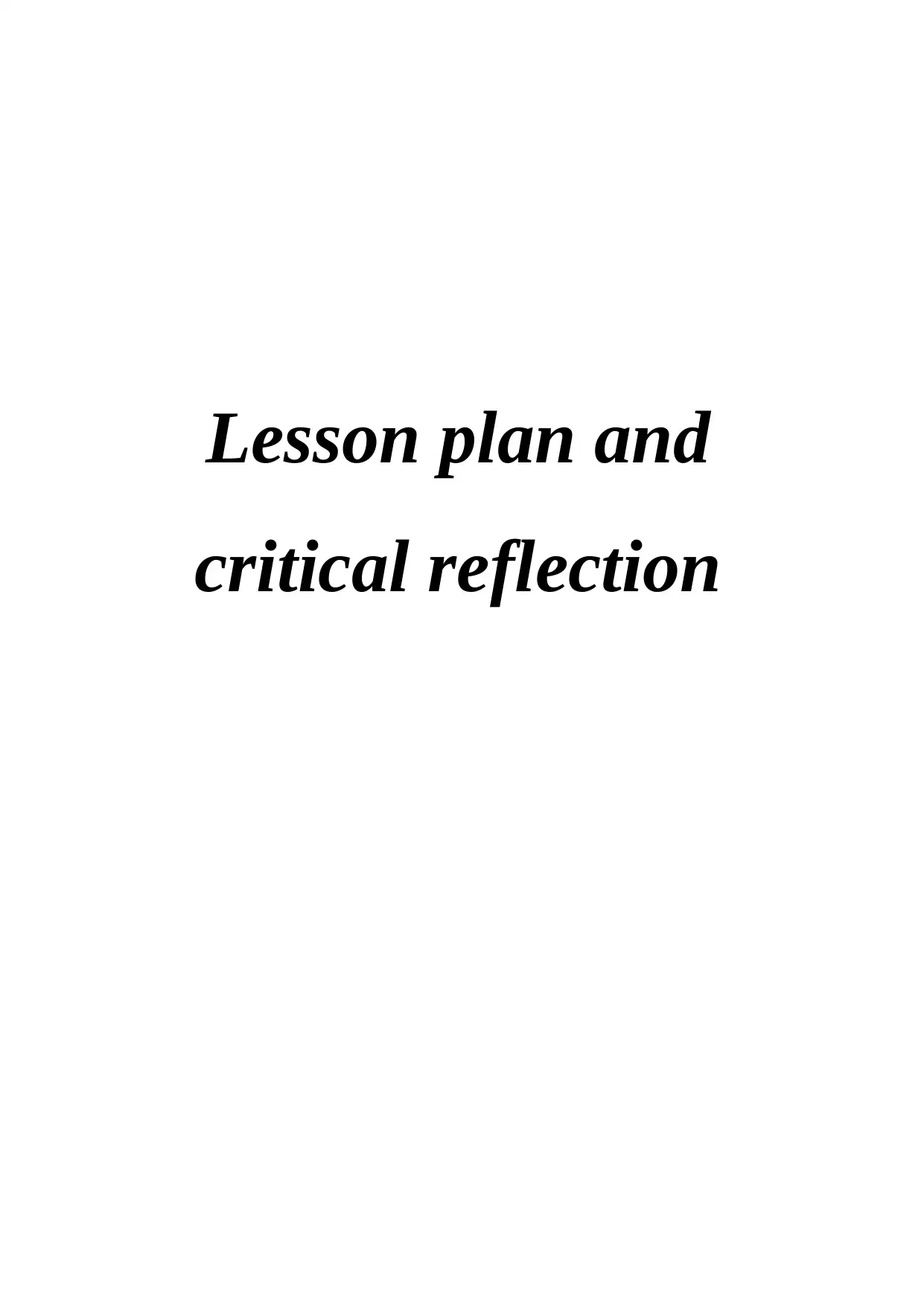
Lesson plan and
critical reflection
critical reflection
Paraphrase This Document
Need a fresh take? Get an instant paraphrase of this document with our AI Paraphraser
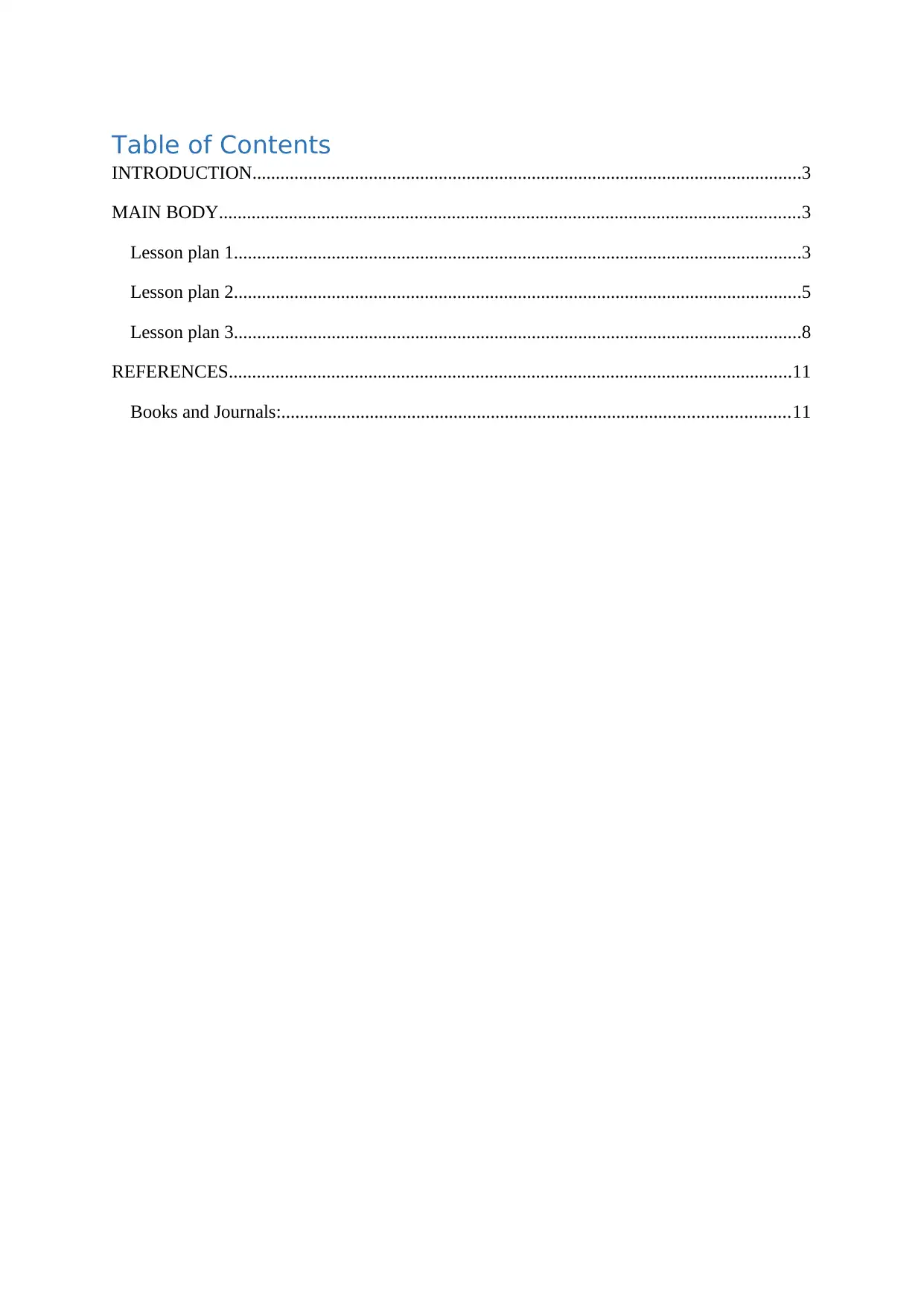
Table of Contents
INTRODUCTION......................................................................................................................3
MAIN BODY.............................................................................................................................3
Lesson plan 1..........................................................................................................................3
Lesson plan 2..........................................................................................................................5
Lesson plan 3..........................................................................................................................8
REFERENCES.........................................................................................................................11
Books and Journals:.............................................................................................................11
INTRODUCTION......................................................................................................................3
MAIN BODY.............................................................................................................................3
Lesson plan 1..........................................................................................................................3
Lesson plan 2..........................................................................................................................5
Lesson plan 3..........................................................................................................................8
REFERENCES.........................................................................................................................11
Books and Journals:.............................................................................................................11
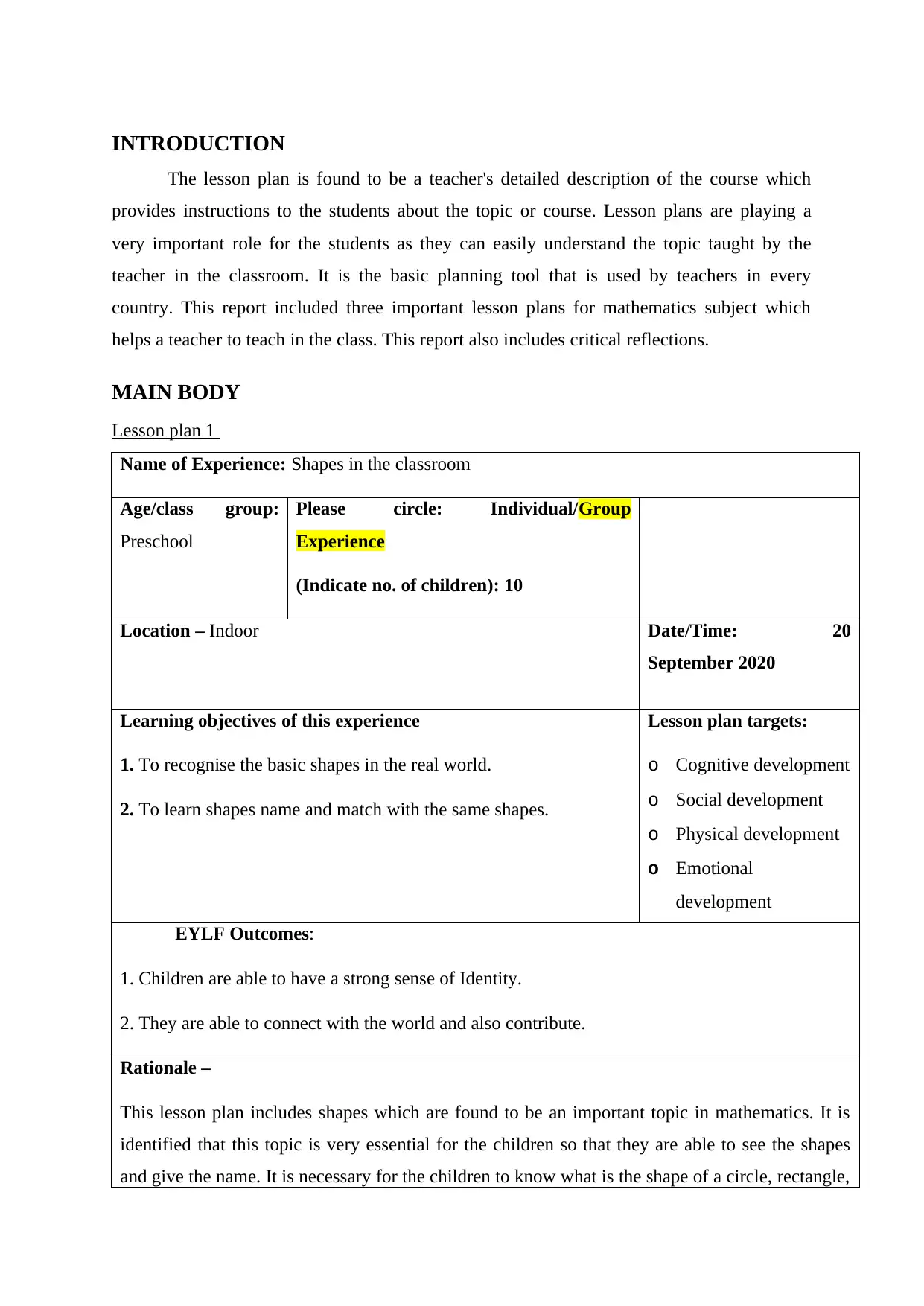
INTRODUCTION
The lesson plan is found to be a teacher's detailed description of the course which
provides instructions to the students about the topic or course. Lesson plans are playing a
very important role for the students as they can easily understand the topic taught by the
teacher in the classroom. It is the basic planning tool that is used by teachers in every
country. This report included three important lesson plans for mathematics subject which
helps a teacher to teach in the class. This report also includes critical reflections.
MAIN BODY
Lesson plan 1
Name of Experience: Shapes in the classroom
Age/class group:
Preschool
Please circle: Individual/Group
Experience
(Indicate no. of children): 10
Location – Indoor Date/Time: 20
September 2020
Learning objectives of this experience
1. To recognise the basic shapes in the real world.
2. To learn shapes name and match with the same shapes.
Lesson plan targets:
o Cognitive development
o Social development
o Physical development
o Emotional
development
EYLF Outcomes:
1. Children are able to have a strong sense of Identity.
2. They are able to connect with the world and also contribute.
Rationale –
This lesson plan includes shapes which are found to be an important topic in mathematics. It is
identified that this topic is very essential for the children so that they are able to see the shapes
and give the name. It is necessary for the children to know what is the shape of a circle, rectangle,
The lesson plan is found to be a teacher's detailed description of the course which
provides instructions to the students about the topic or course. Lesson plans are playing a
very important role for the students as they can easily understand the topic taught by the
teacher in the classroom. It is the basic planning tool that is used by teachers in every
country. This report included three important lesson plans for mathematics subject which
helps a teacher to teach in the class. This report also includes critical reflections.
MAIN BODY
Lesson plan 1
Name of Experience: Shapes in the classroom
Age/class group:
Preschool
Please circle: Individual/Group
Experience
(Indicate no. of children): 10
Location – Indoor Date/Time: 20
September 2020
Learning objectives of this experience
1. To recognise the basic shapes in the real world.
2. To learn shapes name and match with the same shapes.
Lesson plan targets:
o Cognitive development
o Social development
o Physical development
o Emotional
development
EYLF Outcomes:
1. Children are able to have a strong sense of Identity.
2. They are able to connect with the world and also contribute.
Rationale –
This lesson plan includes shapes which are found to be an important topic in mathematics. It is
identified that this topic is very essential for the children so that they are able to see the shapes
and give the name. It is necessary for the children to know what is the shape of a circle, rectangle,
⊘ This is a preview!⊘
Do you want full access?
Subscribe today to unlock all pages.

Trusted by 1+ million students worldwide
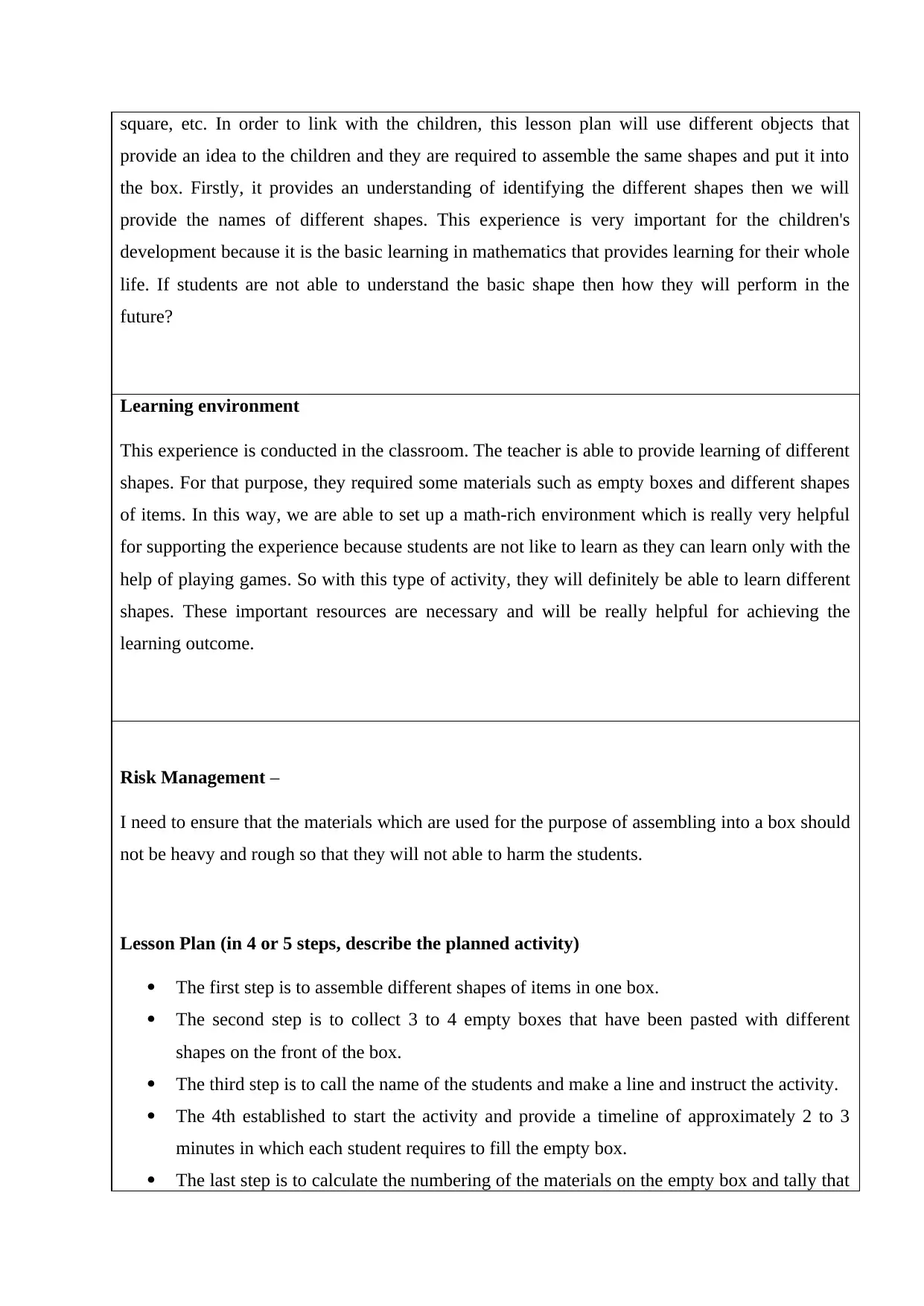
square, etc. In order to link with the children, this lesson plan will use different objects that
provide an idea to the children and they are required to assemble the same shapes and put it into
the box. Firstly, it provides an understanding of identifying the different shapes then we will
provide the names of different shapes. This experience is very important for the children's
development because it is the basic learning in mathematics that provides learning for their whole
life. If students are not able to understand the basic shape then how they will perform in the
future?
Learning environment
This experience is conducted in the classroom. The teacher is able to provide learning of different
shapes. For that purpose, they required some materials such as empty boxes and different shapes
of items. In this way, we are able to set up a math-rich environment which is really very helpful
for supporting the experience because students are not like to learn as they can learn only with the
help of playing games. So with this type of activity, they will definitely be able to learn different
shapes. These important resources are necessary and will be really helpful for achieving the
learning outcome.
Risk Management –
I need to ensure that the materials which are used for the purpose of assembling into a box should
not be heavy and rough so that they will not able to harm the students.
Lesson Plan (in 4 or 5 steps, describe the planned activity)
The first step is to assemble different shapes of items in one box.
The second step is to collect 3 to 4 empty boxes that have been pasted with different
shapes on the front of the box.
The third step is to call the name of the students and make a line and instruct the activity.
The 4th established to start the activity and provide a timeline of approximately 2 to 3
minutes in which each student requires to fill the empty box.
The last step is to calculate the numbering of the materials on the empty box and tally that
provide an idea to the children and they are required to assemble the same shapes and put it into
the box. Firstly, it provides an understanding of identifying the different shapes then we will
provide the names of different shapes. This experience is very important for the children's
development because it is the basic learning in mathematics that provides learning for their whole
life. If students are not able to understand the basic shape then how they will perform in the
future?
Learning environment
This experience is conducted in the classroom. The teacher is able to provide learning of different
shapes. For that purpose, they required some materials such as empty boxes and different shapes
of items. In this way, we are able to set up a math-rich environment which is really very helpful
for supporting the experience because students are not like to learn as they can learn only with the
help of playing games. So with this type of activity, they will definitely be able to learn different
shapes. These important resources are necessary and will be really helpful for achieving the
learning outcome.
Risk Management –
I need to ensure that the materials which are used for the purpose of assembling into a box should
not be heavy and rough so that they will not able to harm the students.
Lesson Plan (in 4 or 5 steps, describe the planned activity)
The first step is to assemble different shapes of items in one box.
The second step is to collect 3 to 4 empty boxes that have been pasted with different
shapes on the front of the box.
The third step is to call the name of the students and make a line and instruct the activity.
The 4th established to start the activity and provide a timeline of approximately 2 to 3
minutes in which each student requires to fill the empty box.
The last step is to calculate the numbering of the materials on the empty box and tally that
Paraphrase This Document
Need a fresh take? Get an instant paraphrase of this document with our AI Paraphraser
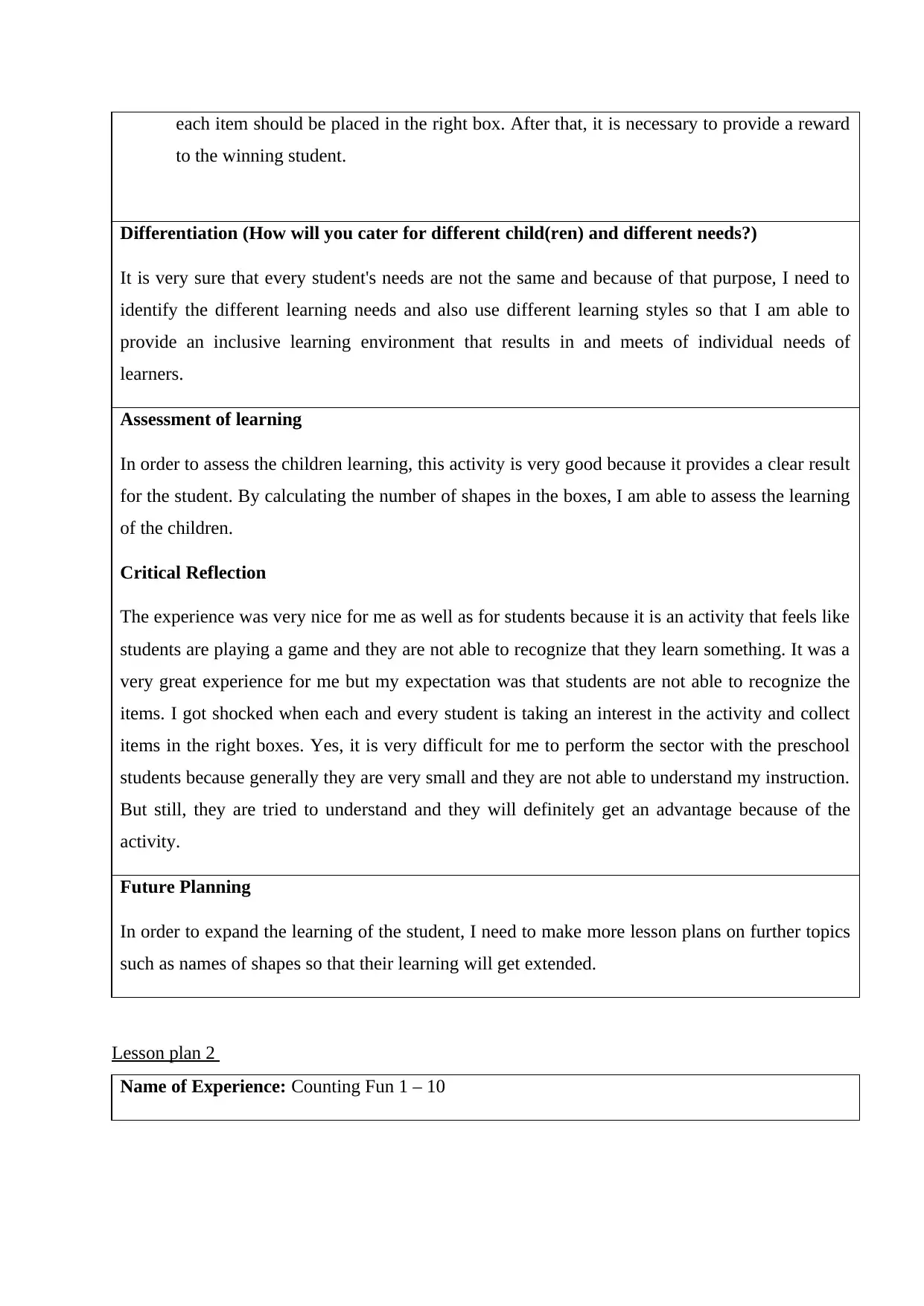
each item should be placed in the right box. After that, it is necessary to provide a reward
to the winning student.
Differentiation (How will you cater for different child(ren) and different needs?)
It is very sure that every student's needs are not the same and because of that purpose, I need to
identify the different learning needs and also use different learning styles so that I am able to
provide an inclusive learning environment that results in and meets of individual needs of
learners.
Assessment of learning
In order to assess the children learning, this activity is very good because it provides a clear result
for the student. By calculating the number of shapes in the boxes, I am able to assess the learning
of the children.
Critical Reflection
The experience was very nice for me as well as for students because it is an activity that feels like
students are playing a game and they are not able to recognize that they learn something. It was a
very great experience for me but my expectation was that students are not able to recognize the
items. I got shocked when each and every student is taking an interest in the activity and collect
items in the right boxes. Yes, it is very difficult for me to perform the sector with the preschool
students because generally they are very small and they are not able to understand my instruction.
But still, they are tried to understand and they will definitely get an advantage because of the
activity.
Future Planning
In order to expand the learning of the student, I need to make more lesson plans on further topics
such as names of shapes so that their learning will get extended.
Lesson plan 2
Name of Experience: Counting Fun 1 – 10
to the winning student.
Differentiation (How will you cater for different child(ren) and different needs?)
It is very sure that every student's needs are not the same and because of that purpose, I need to
identify the different learning needs and also use different learning styles so that I am able to
provide an inclusive learning environment that results in and meets of individual needs of
learners.
Assessment of learning
In order to assess the children learning, this activity is very good because it provides a clear result
for the student. By calculating the number of shapes in the boxes, I am able to assess the learning
of the children.
Critical Reflection
The experience was very nice for me as well as for students because it is an activity that feels like
students are playing a game and they are not able to recognize that they learn something. It was a
very great experience for me but my expectation was that students are not able to recognize the
items. I got shocked when each and every student is taking an interest in the activity and collect
items in the right boxes. Yes, it is very difficult for me to perform the sector with the preschool
students because generally they are very small and they are not able to understand my instruction.
But still, they are tried to understand and they will definitely get an advantage because of the
activity.
Future Planning
In order to expand the learning of the student, I need to make more lesson plans on further topics
such as names of shapes so that their learning will get extended.
Lesson plan 2
Name of Experience: Counting Fun 1 – 10
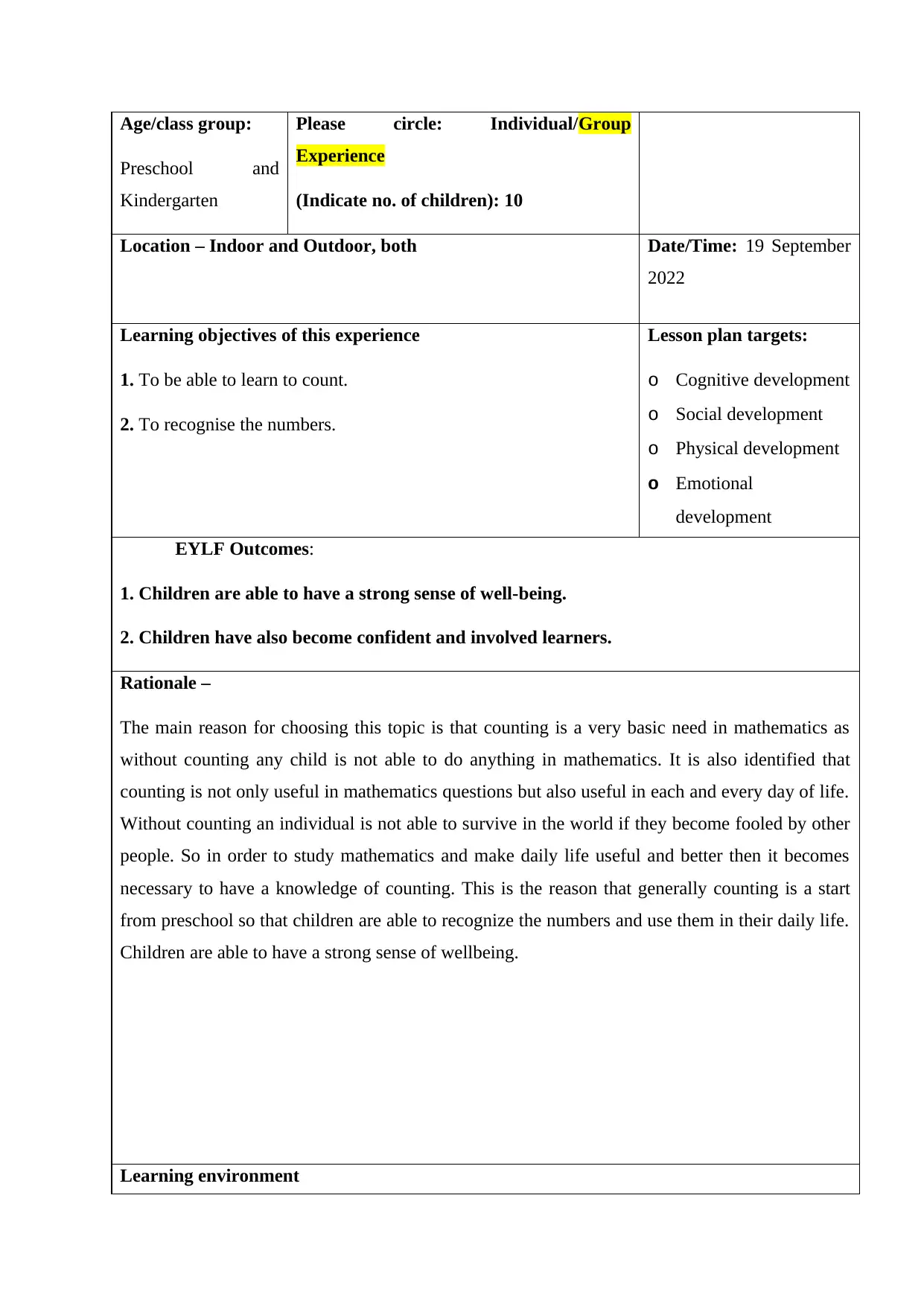
Age/class group:
Preschool and
Kindergarten
Please circle: Individual/Group
Experience
(Indicate no. of children): 10
Location – Indoor and Outdoor, both Date/Time: 19 September
2022
Learning objectives of this experience
1. To be able to learn to count.
2. To recognise the numbers.
Lesson plan targets:
o Cognitive development
o Social development
o Physical development
o Emotional
development
EYLF Outcomes:
1. Children are able to have a strong sense of well-being.
2. Children have also become confident and involved learners.
Rationale –
The main reason for choosing this topic is that counting is a very basic need in mathematics as
without counting any child is not able to do anything in mathematics. It is also identified that
counting is not only useful in mathematics questions but also useful in each and every day of life.
Without counting an individual is not able to survive in the world if they become fooled by other
people. So in order to study mathematics and make daily life useful and better then it becomes
necessary to have a knowledge of counting. This is the reason that generally counting is a start
from preschool so that children are able to recognize the numbers and use them in their daily life.
Children are able to have a strong sense of wellbeing.
Learning environment
Preschool and
Kindergarten
Please circle: Individual/Group
Experience
(Indicate no. of children): 10
Location – Indoor and Outdoor, both Date/Time: 19 September
2022
Learning objectives of this experience
1. To be able to learn to count.
2. To recognise the numbers.
Lesson plan targets:
o Cognitive development
o Social development
o Physical development
o Emotional
development
EYLF Outcomes:
1. Children are able to have a strong sense of well-being.
2. Children have also become confident and involved learners.
Rationale –
The main reason for choosing this topic is that counting is a very basic need in mathematics as
without counting any child is not able to do anything in mathematics. It is also identified that
counting is not only useful in mathematics questions but also useful in each and every day of life.
Without counting an individual is not able to survive in the world if they become fooled by other
people. So in order to study mathematics and make daily life useful and better then it becomes
necessary to have a knowledge of counting. This is the reason that generally counting is a start
from preschool so that children are able to recognize the numbers and use them in their daily life.
Children are able to have a strong sense of wellbeing.
Learning environment
⊘ This is a preview!⊘
Do you want full access?
Subscribe today to unlock all pages.

Trusted by 1+ million students worldwide
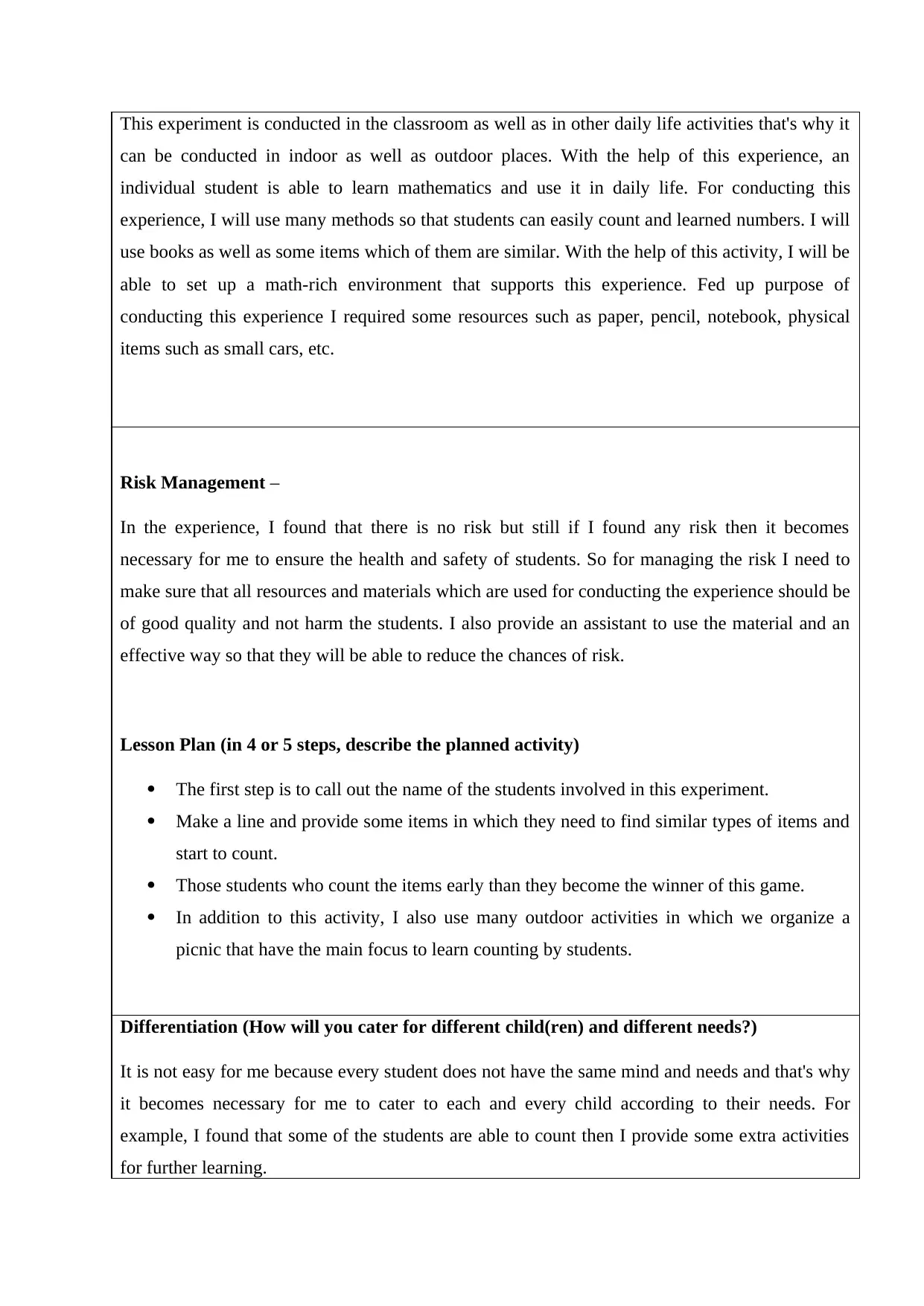
This experiment is conducted in the classroom as well as in other daily life activities that's why it
can be conducted in indoor as well as outdoor places. With the help of this experience, an
individual student is able to learn mathematics and use it in daily life. For conducting this
experience, I will use many methods so that students can easily count and learned numbers. I will
use books as well as some items which of them are similar. With the help of this activity, I will be
able to set up a math-rich environment that supports this experience. Fed up purpose of
conducting this experience I required some resources such as paper, pencil, notebook, physical
items such as small cars, etc.
Risk Management –
In the experience, I found that there is no risk but still if I found any risk then it becomes
necessary for me to ensure the health and safety of students. So for managing the risk I need to
make sure that all resources and materials which are used for conducting the experience should be
of good quality and not harm the students. I also provide an assistant to use the material and an
effective way so that they will be able to reduce the chances of risk.
Lesson Plan (in 4 or 5 steps, describe the planned activity)
The first step is to call out the name of the students involved in this experiment.
Make a line and provide some items in which they need to find similar types of items and
start to count.
Those students who count the items early than they become the winner of this game.
In addition to this activity, I also use many outdoor activities in which we organize a
picnic that have the main focus to learn counting by students.
Differentiation (How will you cater for different child(ren) and different needs?)
It is not easy for me because every student does not have the same mind and needs and that's why
it becomes necessary for me to cater to each and every child according to their needs. For
example, I found that some of the students are able to count then I provide some extra activities
for further learning.
can be conducted in indoor as well as outdoor places. With the help of this experience, an
individual student is able to learn mathematics and use it in daily life. For conducting this
experience, I will use many methods so that students can easily count and learned numbers. I will
use books as well as some items which of them are similar. With the help of this activity, I will be
able to set up a math-rich environment that supports this experience. Fed up purpose of
conducting this experience I required some resources such as paper, pencil, notebook, physical
items such as small cars, etc.
Risk Management –
In the experience, I found that there is no risk but still if I found any risk then it becomes
necessary for me to ensure the health and safety of students. So for managing the risk I need to
make sure that all resources and materials which are used for conducting the experience should be
of good quality and not harm the students. I also provide an assistant to use the material and an
effective way so that they will be able to reduce the chances of risk.
Lesson Plan (in 4 or 5 steps, describe the planned activity)
The first step is to call out the name of the students involved in this experiment.
Make a line and provide some items in which they need to find similar types of items and
start to count.
Those students who count the items early than they become the winner of this game.
In addition to this activity, I also use many outdoor activities in which we organize a
picnic that have the main focus to learn counting by students.
Differentiation (How will you cater for different child(ren) and different needs?)
It is not easy for me because every student does not have the same mind and needs and that's why
it becomes necessary for me to cater to each and every child according to their needs. For
example, I found that some of the students are able to count then I provide some extra activities
for further learning.
Paraphrase This Document
Need a fresh take? Get an instant paraphrase of this document with our AI Paraphraser
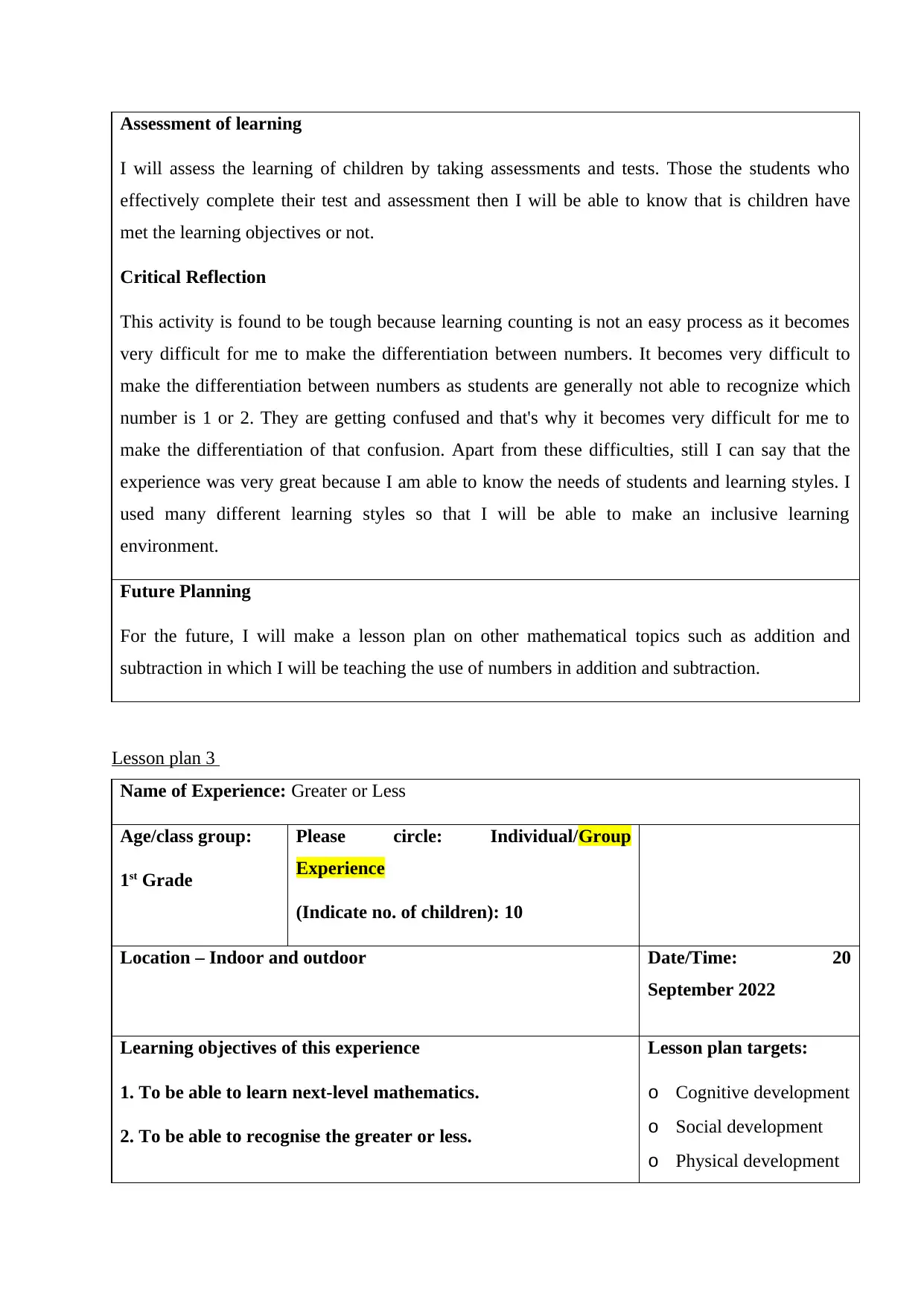
Assessment of learning
I will assess the learning of children by taking assessments and tests. Those the students who
effectively complete their test and assessment then I will be able to know that is children have
met the learning objectives or not.
Critical Reflection
This activity is found to be tough because learning counting is not an easy process as it becomes
very difficult for me to make the differentiation between numbers. It becomes very difficult to
make the differentiation between numbers as students are generally not able to recognize which
number is 1 or 2. They are getting confused and that's why it becomes very difficult for me to
make the differentiation of that confusion. Apart from these difficulties, still I can say that the
experience was very great because I am able to know the needs of students and learning styles. I
used many different learning styles so that I will be able to make an inclusive learning
environment.
Future Planning
For the future, I will make a lesson plan on other mathematical topics such as addition and
subtraction in which I will be teaching the use of numbers in addition and subtraction.
Lesson plan 3
Name of Experience: Greater or Less
Age/class group:
1st Grade
Please circle: Individual/Group
Experience
(Indicate no. of children): 10
Location – Indoor and outdoor Date/Time: 20
September 2022
Learning objectives of this experience
1. To be able to learn next-level mathematics.
2. To be able to recognise the greater or less.
Lesson plan targets:
o Cognitive development
o Social development
o Physical development
I will assess the learning of children by taking assessments and tests. Those the students who
effectively complete their test and assessment then I will be able to know that is children have
met the learning objectives or not.
Critical Reflection
This activity is found to be tough because learning counting is not an easy process as it becomes
very difficult for me to make the differentiation between numbers. It becomes very difficult to
make the differentiation between numbers as students are generally not able to recognize which
number is 1 or 2. They are getting confused and that's why it becomes very difficult for me to
make the differentiation of that confusion. Apart from these difficulties, still I can say that the
experience was very great because I am able to know the needs of students and learning styles. I
used many different learning styles so that I will be able to make an inclusive learning
environment.
Future Planning
For the future, I will make a lesson plan on other mathematical topics such as addition and
subtraction in which I will be teaching the use of numbers in addition and subtraction.
Lesson plan 3
Name of Experience: Greater or Less
Age/class group:
1st Grade
Please circle: Individual/Group
Experience
(Indicate no. of children): 10
Location – Indoor and outdoor Date/Time: 20
September 2022
Learning objectives of this experience
1. To be able to learn next-level mathematics.
2. To be able to recognise the greater or less.
Lesson plan targets:
o Cognitive development
o Social development
o Physical development
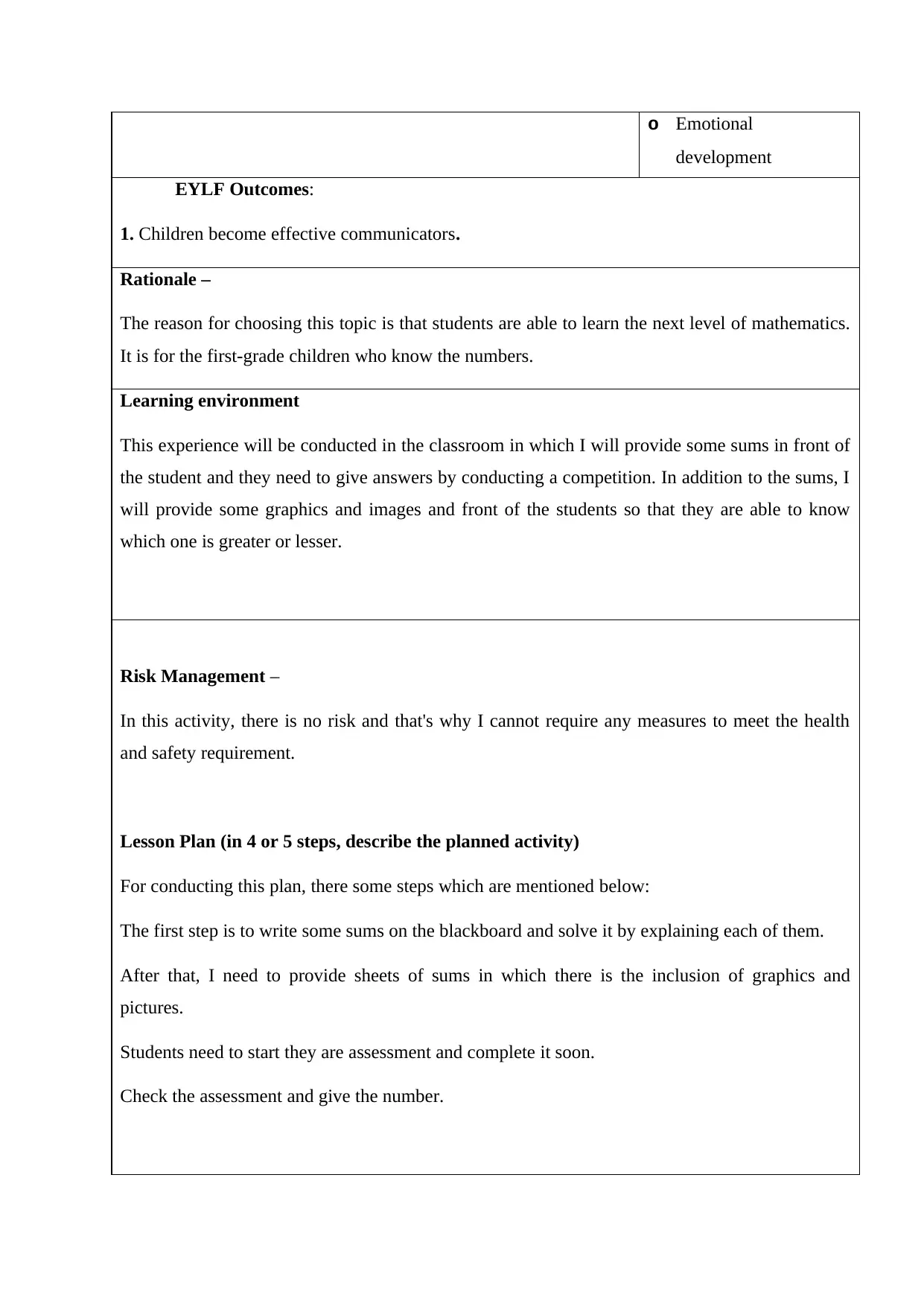
o Emotional
development
EYLF Outcomes:
1. Children become effective communicators.
Rationale –
The reason for choosing this topic is that students are able to learn the next level of mathematics.
It is for the first-grade children who know the numbers.
Learning environment
This experience will be conducted in the classroom in which I will provide some sums in front of
the student and they need to give answers by conducting a competition. In addition to the sums, I
will provide some graphics and images and front of the students so that they are able to know
which one is greater or lesser.
Risk Management –
In this activity, there is no risk and that's why I cannot require any measures to meet the health
and safety requirement.
Lesson Plan (in 4 or 5 steps, describe the planned activity)
For conducting this plan, there some steps which are mentioned below:
The first step is to write some sums on the blackboard and solve it by explaining each of them.
After that, I need to provide sheets of sums in which there is the inclusion of graphics and
pictures.
Students need to start they are assessment and complete it soon.
Check the assessment and give the number.
development
EYLF Outcomes:
1. Children become effective communicators.
Rationale –
The reason for choosing this topic is that students are able to learn the next level of mathematics.
It is for the first-grade children who know the numbers.
Learning environment
This experience will be conducted in the classroom in which I will provide some sums in front of
the student and they need to give answers by conducting a competition. In addition to the sums, I
will provide some graphics and images and front of the students so that they are able to know
which one is greater or lesser.
Risk Management –
In this activity, there is no risk and that's why I cannot require any measures to meet the health
and safety requirement.
Lesson Plan (in 4 or 5 steps, describe the planned activity)
For conducting this plan, there some steps which are mentioned below:
The first step is to write some sums on the blackboard and solve it by explaining each of them.
After that, I need to provide sheets of sums in which there is the inclusion of graphics and
pictures.
Students need to start they are assessment and complete it soon.
Check the assessment and give the number.
⊘ This is a preview!⊘
Do you want full access?
Subscribe today to unlock all pages.

Trusted by 1+ million students worldwide
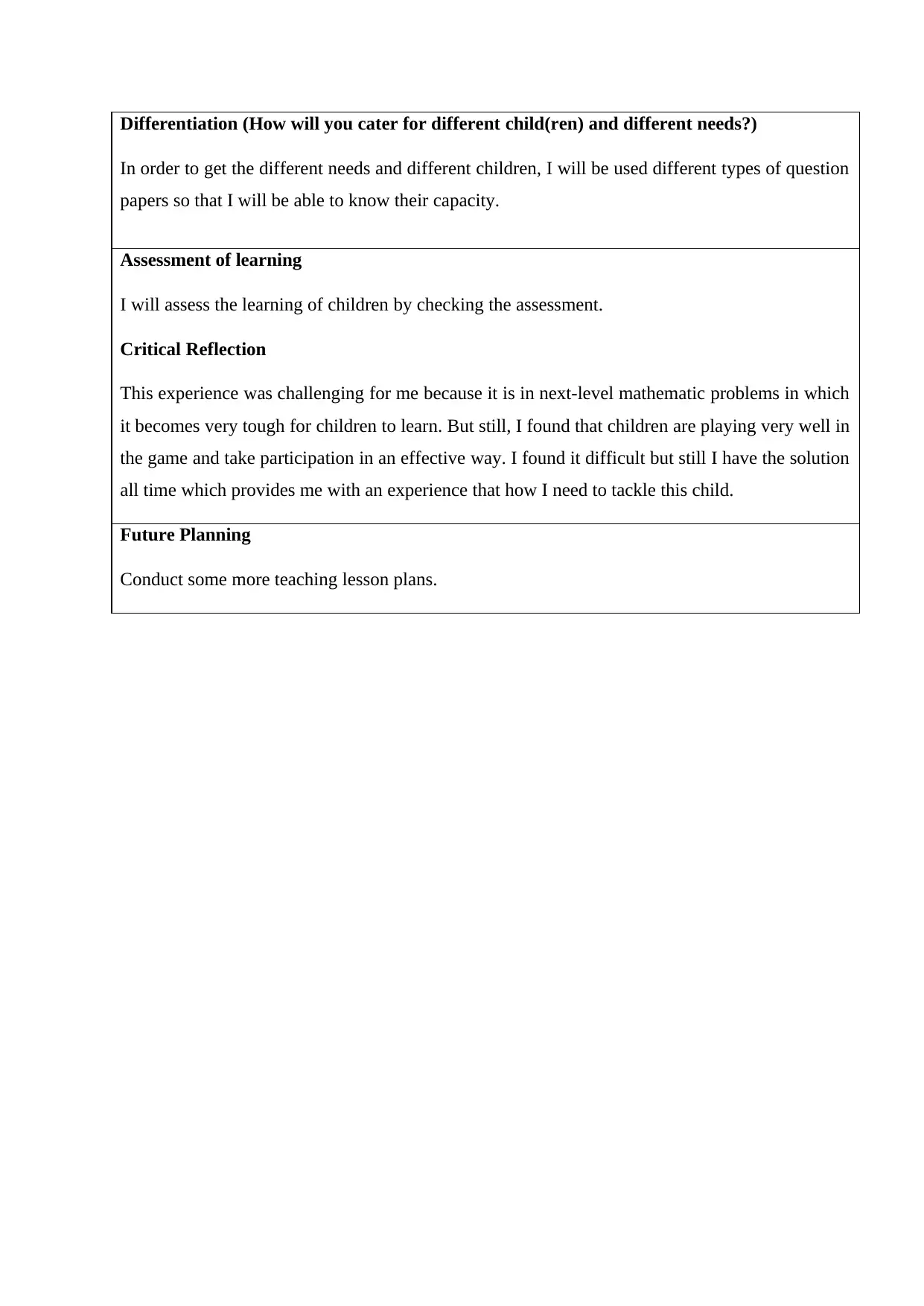
Differentiation (How will you cater for different child(ren) and different needs?)
In order to get the different needs and different children, I will be used different types of question
papers so that I will be able to know their capacity.
Assessment of learning
I will assess the learning of children by checking the assessment.
Critical Reflection
This experience was challenging for me because it is in next-level mathematic problems in which
it becomes very tough for children to learn. But still, I found that children are playing very well in
the game and take participation in an effective way. I found it difficult but still I have the solution
all time which provides me with an experience that how I need to tackle this child.
Future Planning
Conduct some more teaching lesson plans.
In order to get the different needs and different children, I will be used different types of question
papers so that I will be able to know their capacity.
Assessment of learning
I will assess the learning of children by checking the assessment.
Critical Reflection
This experience was challenging for me because it is in next-level mathematic problems in which
it becomes very tough for children to learn. But still, I found that children are playing very well in
the game and take participation in an effective way. I found it difficult but still I have the solution
all time which provides me with an experience that how I need to tackle this child.
Future Planning
Conduct some more teaching lesson plans.
Paraphrase This Document
Need a fresh take? Get an instant paraphrase of this document with our AI Paraphraser
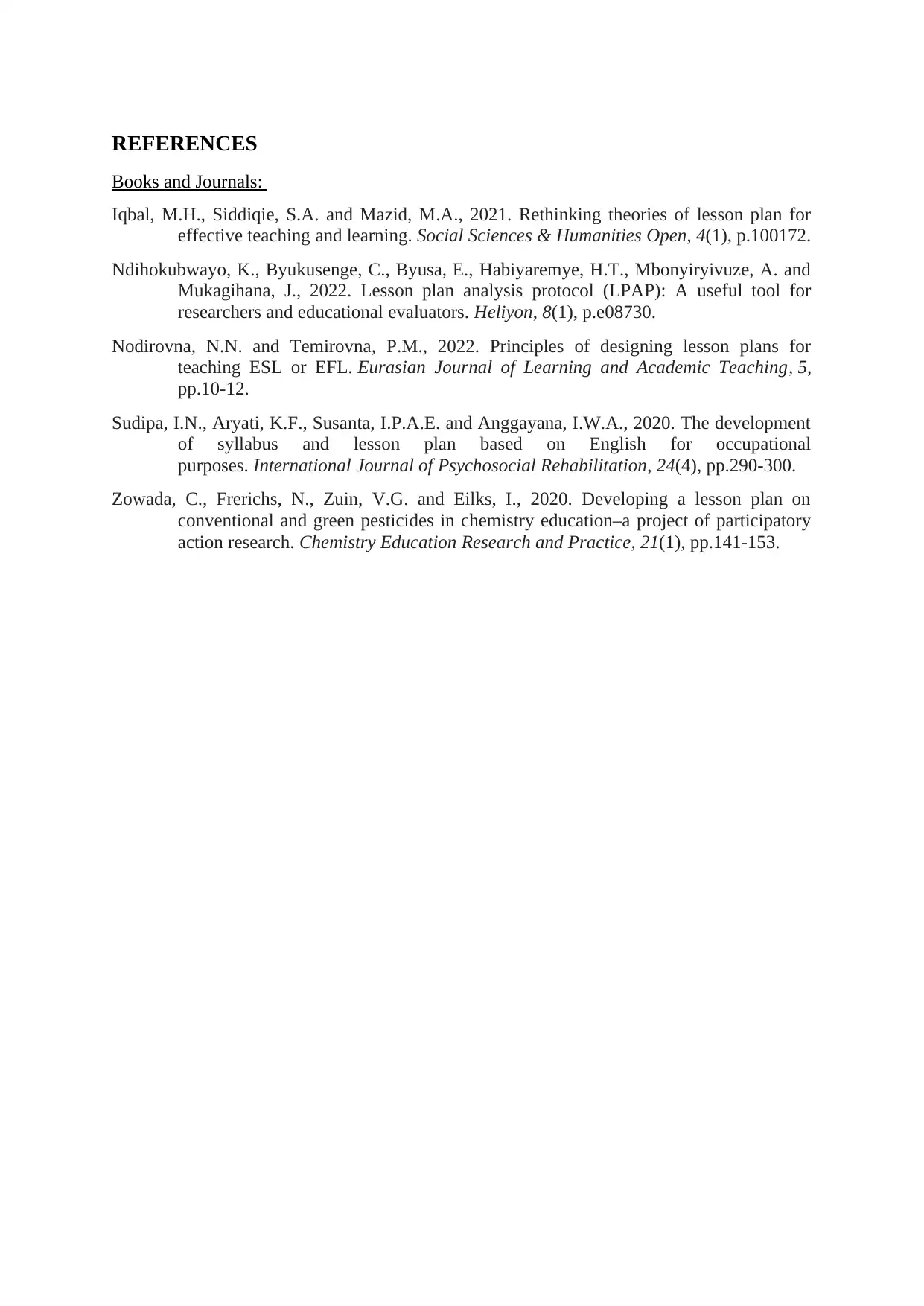
REFERENCES
Books and Journals:
Iqbal, M.H., Siddiqie, S.A. and Mazid, M.A., 2021. Rethinking theories of lesson plan for
effective teaching and learning. Social Sciences & Humanities Open, 4(1), p.100172.
Ndihokubwayo, K., Byukusenge, C., Byusa, E., Habiyaremye, H.T., Mbonyiryivuze, A. and
Mukagihana, J., 2022. Lesson plan analysis protocol (LPAP): A useful tool for
researchers and educational evaluators. Heliyon, 8(1), p.e08730.
Nodirovna, N.N. and Temirovna, P.M., 2022. Principles of designing lesson plans for
teaching ESL or EFL. Eurasian Journal of Learning and Academic Teaching, 5,
pp.10-12.
Sudipa, I.N., Aryati, K.F., Susanta, I.P.A.E. and Anggayana, I.W.A., 2020. The development
of syllabus and lesson plan based on English for occupational
purposes. International Journal of Psychosocial Rehabilitation, 24(4), pp.290-300.
Zowada, C., Frerichs, N., Zuin, V.G. and Eilks, I., 2020. Developing a lesson plan on
conventional and green pesticides in chemistry education–a project of participatory
action research. Chemistry Education Research and Practice, 21(1), pp.141-153.
Books and Journals:
Iqbal, M.H., Siddiqie, S.A. and Mazid, M.A., 2021. Rethinking theories of lesson plan for
effective teaching and learning. Social Sciences & Humanities Open, 4(1), p.100172.
Ndihokubwayo, K., Byukusenge, C., Byusa, E., Habiyaremye, H.T., Mbonyiryivuze, A. and
Mukagihana, J., 2022. Lesson plan analysis protocol (LPAP): A useful tool for
researchers and educational evaluators. Heliyon, 8(1), p.e08730.
Nodirovna, N.N. and Temirovna, P.M., 2022. Principles of designing lesson plans for
teaching ESL or EFL. Eurasian Journal of Learning and Academic Teaching, 5,
pp.10-12.
Sudipa, I.N., Aryati, K.F., Susanta, I.P.A.E. and Anggayana, I.W.A., 2020. The development
of syllabus and lesson plan based on English for occupational
purposes. International Journal of Psychosocial Rehabilitation, 24(4), pp.290-300.
Zowada, C., Frerichs, N., Zuin, V.G. and Eilks, I., 2020. Developing a lesson plan on
conventional and green pesticides in chemistry education–a project of participatory
action research. Chemistry Education Research and Practice, 21(1), pp.141-153.
1 out of 11
Related Documents
Your All-in-One AI-Powered Toolkit for Academic Success.
+13062052269
info@desklib.com
Available 24*7 on WhatsApp / Email
![[object Object]](/_next/static/media/star-bottom.7253800d.svg)
Unlock your academic potential
Copyright © 2020–2025 A2Z Services. All Rights Reserved. Developed and managed by ZUCOL.





